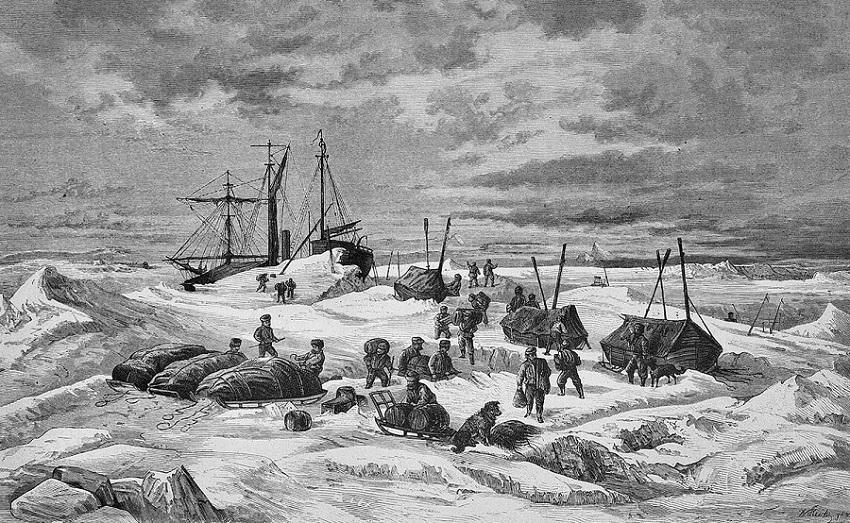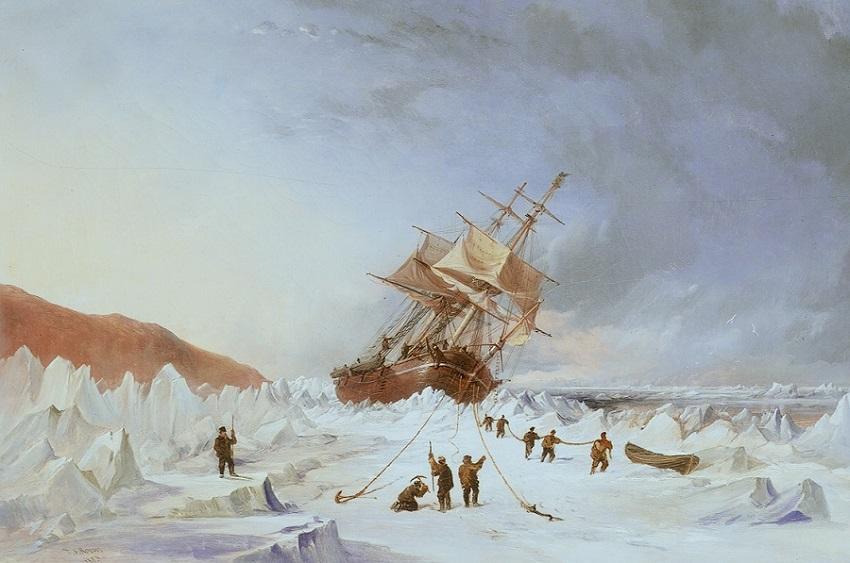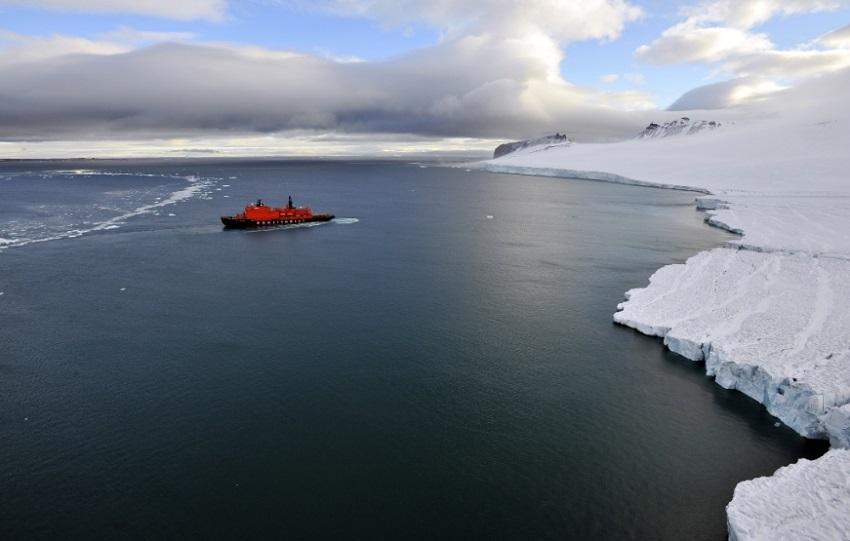
The first Arctic explorations in the 11th-17th centuries
In the 11th century, Russian navigators began to explore the coast of the Arctic Ocean. In 1032, according to the entry in the Nikon Chronicle, the Novgorod posadnik Uleb made a trip from the Northern Dvina to the “Iron Gate”, that is, to the Kara Gate Strait or to the Yugorsky Shar Strait (separating the Southern Island of the Novaya Zemlya archipelago and the island of Vaigach from the mainland and from each other).
In the 12th and 13th centuries, the Pomors explored the islands of Vaigach and Novaya Zemlya, and at the end of the 15th century, the islands of the Svalbard archipelago and Medvezhy Island in the Barents Sea. The peasant colonization of the White Sea region began in the 13th century. In 1499, Pustozersk, the first Russian polar city, was founded in the lower reaches of the Pechora (it existed until the 1960s; it was located 20 km from the current city of Naryan-Mar).
In 1533, the Trifonov Pechenga Monastery was founded on the Murmansk coast of the Barents Sea, which, along with the Solovetsky Monastery on the island of the same name in the White Sea (1429), became an important Arctic exploration point. Arkhangelsk, founded in 1584, remained the main Russian port in the European north of Russia until the 20th century.
In the 16th and 17th centuries, Russian merchants actively explored the so-called Mangazey Sea Passage, a section of the Northern Sea Route (NSR) from the mouth of the Northern Dvina to the Taz Bay at the mouth of the Ob River. In 1601, by royal decree, the city of Mangazeya was built on the Taz River (it existed until 1672), which was a commercial and military outpost of the Russian state in the Arctic. During the same period, oil began to be extracted by artisanal methods on the Ukhta River: it was collected from the surface of the water and in coastal pits.
XVII-XVIII centuries
In 1648, the Cossack chieftain Semyon Dezhnev set sail along the shores of Chukotka. He discovered the strait between Asia and America, drew up a drawing of the Anadyr and Anyui rivers. In 1686-1688, Ivan Tolstoukhov’s trading expedition circumnavigated the Taimyr Peninsula by sea from west to east.
In 1712, the explorers Mercury Vagin and Yakov Permyakov initiated the exploration of the New Siberian Islands. In 1728, during the First Kamchatka Expedition (1728-1729), organized by decree of Emperor Peter I, Vitus Bering, an officer of the Russian Navy, confirmed the existence of a strait separating Chukotka and Alaska.
In 1733-1743, the Russian Arctic was explored by the Great Northern Expedition of Vitus Bering, brothers Dmitry and Khariton Laptev, Stepan Malygin, Semyon Chelyuskin and others. During their sea and hiking trips, the participants mapped almost the entire Russian coast of the Arctic Ocean, as well as the shores of the Okhotsk and Bering Seas. They described the Alaska Peninsula, the Aleutian and Commander Islands.

Her Majesty’s Ship Ice Rescue, Thomas Sewell Robins, 1853
In 1741-1742, Semyon Chelyuskin described the western and northern coasts of the Taimyr Peninsula on foot, where he identified the northern tip of Asia, which in 1843 was named Cape Chelyuskin in his honor.
In 1746, based on the materials of the Great Northern Expedition, a “Map of the territory of the Russian Empire, the northern and eastern coasts adjacent to the Arctic and Eastern Oceans, with part of the newly discovered western American coasts and the islands of Japan, was compiled.”
In 1765, according to a plan developed by the Russian scientist Mikhail Lomonosov, the Arctic Expedition of Vasily Chichagov was organized. The purpose of the trip was to search for a sea passage from Svalbard to Kamchatka through waters close to the North Pole. Despite the failure, the materials of the expedition significantly enriched Russian science.
In 1799, the Russian-American commercial and industrial company was founded, whose activities contributed to the exploration and development of Alaska and the Aleutian Islands by Russian settlers.
XIX – early XX century
In 1820-1824, an expedition led by Ferdinand Wrangel and Fyodor Matyushkin, Pushkin’s lyceum friend, explored the coast of the Arctic Ocean from the mouth of the Kolyma River to Kolyuchinskaya Bay in Chukotka. In the same years, the polar explorer Fyodor Litke compiled a cartographic description of the Novaya Zemlya archipelago.
In 1873, the Austro-Hungarian expedition of Julius Payer and Karl Weyprecht discovered the Franz Josef Land archipelago, which was declared a Russian territory in 1914.
In 1878-1879, an expedition by the Swedish explorer Baron Nils Nordenskiold took place, funded jointly by the Swedish government, Swedish and Russian entrepreneurs. For the first time in history, she managed to pass through the Northern Sea Route and exit through the Bering Strait into the Pacific Ocean.
Since the end of the 19th century, the settlement of the Russian Arctic has intensified. In the 1870s, the Arkhangelsk governors organized the resettlement of the Nenets to the islands of the Novaya Zemlya archipelago for permanent residence. In 1894, the Government of the Russian Empire, on the initiative of Finance Minister Sergei Witte, developed a plan for the development of the Far North. It was planned to build a port and a railway on the Kola Peninsula.
According to this plan, in 1898, the military port of Alexandrovsky (now Polyarny) was laid in the Catherine Harbor of the Kola Bay, and in 1916 – Romanov-on-Murman (now Murmansk). In order to develop this territory as soon as possible, the settlers were provided with benefits: all residents were exempt from paying taxes, and men were exempt from compulsory military service.
In 1900-1902, the Imperial Academy of Sciences equipped a Russian polar expedition led by Baron Eduard Toll and Fleet Lieutenant Alexander Kolchak. She conducted a study of the New Siberian Islands and mapped about two hundred new geographical names in the Arctic.
In 1913-1915, a hydrographic expedition led by Boris Vilkitsky discovered the Severnaya Zemlya archipelago, and then made the first ever voyage by the Northern Sea Route from Vladivostok to Arkhangelsk.
The Soviet period

In the 1920s and 1930s, the USSR launched an extensive program of government activities for the study and development of the Far North. On March 4, 1920, the Presidium of the Supreme Council of the National Economy of the RSFSR approved the regulations on the Northern Scientific and Commercial Expedition (Sevexpedition; since 1925 – the Institute for the Study of the North, since 1958 – the Arctic and Antarctic Research Institute).
She was tasked with coordinating all scientific research activities in the Arctic. On April 15, 1926, a resolution of the Presidium of the Central Executive Committee of the USSR was adopted, according to which all lands and islands between the meridians of 32°4’35” east longitude and 168°49’30” west longitude located in the Arctic Ocean north of the coast of the USSR and to the North Pole were declared the territory of the Soviet Union.
In 1931, the first industrial oil field in the Russian North was discovered – Chibyusskoye (Northern Territory, now the Komi Republic). Mining began on it in 1939. In 1932, the Main Directorate of the Northern Sea Route (Glavsevmorput) was established under the Council of People’s Commissars of the USSR, which was charged with the national economic development of the Arctic and ensuring navigation along the Northern Sea Route from the White Sea to the Bering Strait.
In addition, the Main Northern Sea Route was responsible for organizing geological work, prospecting and exploration of minerals in the Arctic. The first head of the department in 1932 was the polar explorer Otto Schmidt. In the same year, he led the cruise of the icebreaking steamer Sibiryakov, which passed the NSR in one navigation (65 days).
In 1937, Soviet pilots Valery Chkalov and Mikhail Gromov flew over the North Pole for the first time. In the same year, the first drifting scientific station “North Pole” was organized in the USSR. Subsequently, such stations operated in the Central Arctic until 1991 (the program also operated in 2003-2015).
In the 1930s and 1940s, active settlement and industrial development of the Arctic began in the USSR, including using the labor of political prisoners. During this period, the Arctic ports of Igarka, Dikson, Pevek, Tiksi were built, and the cities of Naryan-Mar, Norilsk, Vorkuta, and others were founded. At the same time, the first large oil and gas reserves were discovered in the Arctic regions of Western Siberia.
In 1948, the Scientific Research Institute of Arctic Geology (now the All-Russian Scientific Research Institute of Geology and Mineral Resources of the World Ocean) was established in Leningrad (now St. Petersburg) to activate geological exploration in the region. academician I. S. Gramberg).
In 1959, the world’s first nuclear icebreaker Lenin was commissioned. And in 1977, the Soviet nuclear icebreaker Arktika became the first surface vessel in the world to reach the geographical point of the North Pole.
In the 1960s and 1970s, the largest oil and gas fields were discovered: Urengoyskoye (1966), Yamburgskoye (1969), Bovanenkovskoye (1971) and others. In the 1980s, oil and gas fields were discovered on the Arctic shelf: Shtokmanovskoye (1988), Prirazlomnoye (1989) and others.
TASS


